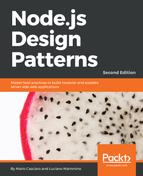- Node.js Design Patterns - Second Edition
- Node.js Design Patterns - Second Edition
- Credits
- About the Authors
- Acknowledgments
- About the Author
- Acknowledgments
- About the Reviewers
- www.PacktPub.com
- Preface
- 1. Welcome to the Node.js Platform
- 2. Node.js Essential Patterns
- 3. Asynchronous Control Flow Patterns with Callbacks
- 4. Asynchronous Control Flow Patterns with ES2015 and Beyond
- 5. Coding with Streams
- Discovering the importance of streams
- Getting started with streams
- Asynchronous control flow with streams
- Piping patterns
- Summary
- 6. Design Patterns
- 7. Wiring Modules
- 8. Universal JavaScript for Web Applications
- 9. Advanced Asynchronous Recipes
- 10. Scalability and Architectural Patterns
- An introduction to application scaling
- Cloning and load balancing
- Decomposing complex applications
- Summary
- 11. Messaging and Integration Patterns
- Fundamentals of a messaging system
- Publish/subscribe pattern
- Pipelines and task distribution patterns
- Request/reply patterns
- Summary
We have reached the end of this chapter. Here, we learned the most important messaging and integration patterns and the role they play in the design of distributed systems. We made our acquaintance with the three major types of message exchange patterns: publish/subscribe, pipelines, and request/reply, and we saw how they can be implemented using a peer-to-peer architecture or a message broker. We analyzed their pros and cons, and we saw that by using AMQP and a fully-fledged message broker, we can implement reliable and scalable applications with little developmental effort but at a cost of having one more system to maintain and scale. Also, we saw how ØMQ allows us to build distributed systems where we can have total control over every aspect of the architecture, fine tuning its properties around our very own requirements.
This chapter also closes the book; by now, we should have a tool belt full of patterns and techniques we can go and apply in our projects. We should also have a deeper understanding of how Node.js development works and what its strengths and weaknesses are. Throughout the book, we also had the chance to work with a myriad of packages and solutions developed by many extraordinary developers. In the end, this is the most beautiful aspect of Node.js: its people, a community where everybody plays their part in giving back something.
I hope you enjoyed our small contribution.
-
No Comment
